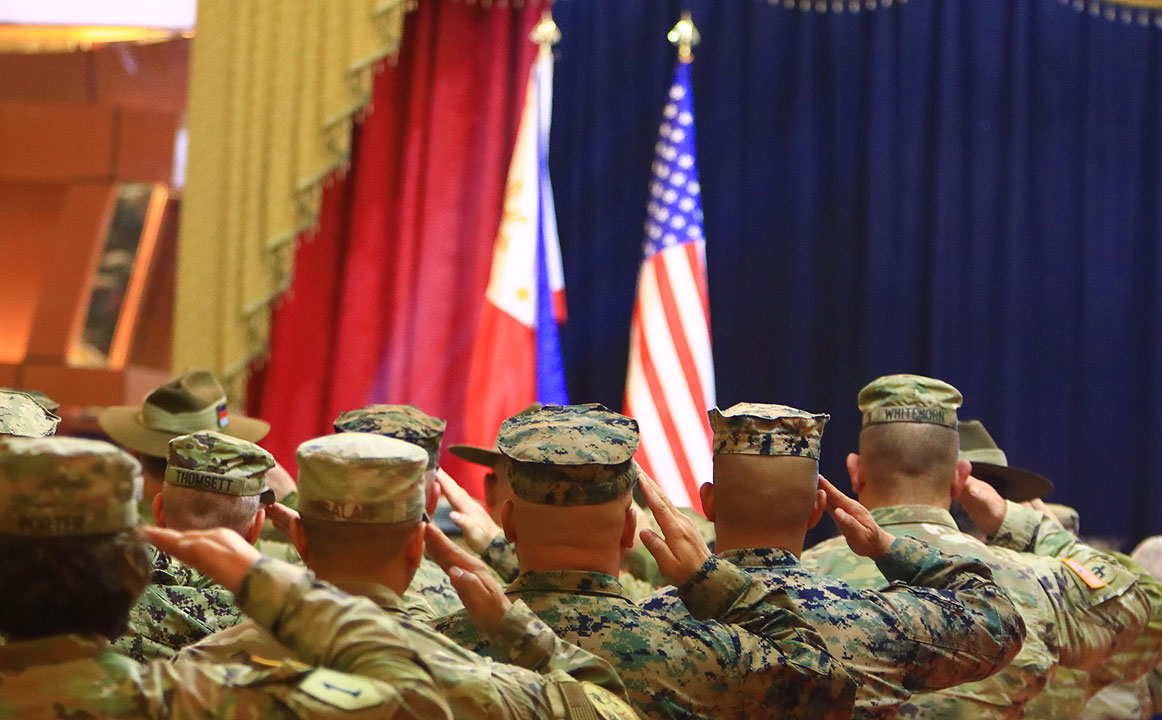Philippines: Military bases may be used in ‘emergency situations’

By John Victor D. Ordoñez, Reporter
PHILIPPINE military bases under the Enhanced Defense Cooperation Agreement (EDCA) with the US may be used by both countries during “emergency situations” aside from disaster relief, according to the Philippine military.
“EDCA facilities may be used by the Armed Forces of the Philippines (AFP) in ordinary days but of course, this will also be made available during emergency situations for combined use by the US and AFP,” military spokesman Colonel Medel M. Aguilar told a news briefing in Manila on Wednesday.
“These properties will remain to be under our possession, our own properties, facilities and everything that will be brought in inside these facilities will be coordinated and cleared with the AFP,” he added.
President Ferdinand R. Marcos, Jr. on Monday ruled out the use of Philippine military bases, access to which by American troops under the 2014 military pact has been widened, to launch offensives.
“We will not let our bases be used for whatever offensive actions,” he told reporters on the sidelines of a commemoration event for Filipino heroes of World War II.
Mr. Aguilar said the Philippines would benefit from the deal because these facilities will one day be turned over to the country’s military.
The US has committed to allot more than $100 million to develop Philippine military bases under EDCA by the end of the year, against the $83 million it had set aside, US Secretary Lloyd James Austin III told a separate livestreamed news briefing from Washington.
He said his Philippine counterpart, Carlito G. Galvez, Jr., and Foreign Affairs Secretary Enrique A. Manalo had agreed to complete a roadmap for US security assistance in the next five to 10 years.
Mr. Galvez and Mr. Manalo were also at the briefing in Washington.
“I think it’s too early to try to discuss specific numbers and the timing of military rotations, but certainly, these are things that Secretary Galvez and I will continue to work on going forward,” Mr. Austin said.
“Whatever we do in terms of rotations and numbers of troops, it is a joint decision between the Philippine government and the US government.”
Mr. Austin said Washington’s investments in the military bases would boost job creation and economic growth in Philippine communities.
The military assistance roadmap would tackle the delivery of military equipment such as radars, unmanned aerial systems, military transport aircraft and coastal and defense systems.
Mr. Marcos in February gave the US access to four more military bases under EDCA on top of the five existing sites. China has criticized the EDCA expansion, accusing the US of endangering “regional peace and stability.”
The Philippines and US kicked off their biggest joint military exercises on Tuesday, which will run until April 28. There will be observers from Japan, South Korea, the United Kingdom, France, India and other Southeast Asian countries.
Mr. Aguilar said Mr. Marcos had shown “great interest” in the military exercises.
At the Washington briefing, Mr. Galvez said he does not expect any negative reactions from China amid the war games.
“We’ve been doing Balikatan yearly,” he said. “We don’t expect any violent reaction, considering that these exercises are intended for our collective defense with the US and other allies.”
Mr. Manalo said the use of the EDCA sites by American troops was still up for discussion.
EDCA is a supplementary deal to the 1999 visiting forces agreement, which allows the US to rotate troops in the Philippines and build and operate facilities on agreed locations for both their military forces.
Three of the four new EDCA locations will be in northern Philippines — Naval Base Camilo Osias in Sta Ana, Cagayan; Lal-lo Airport, also in Cagayan; and Camp Melchor Dela Cruz in Gamu, Isabela.
Cagayan is about 1,000 kilometers away from self-ruled Taiwan, which China considers part of its territory. Balabac Island in Palawan, which is facing the South China Sea, is also on the list.
The Balikatan war games come after a three-day Chinese military exercise that simulated targeted strikes and a blockade of Taiwan.
‘FORGING NEW TIES’
“Exchange and cooperation between relevant countries should not target any third party and should be conducive to regional peace and stability,” Chinese Foreign Ministry spokesman Wang Wenbin told a news briefing on Wednesday, based on a transcript sent to reporters.
He said the Philippine-US cooperation should not be allowed to interfere in disputes in the South China Sea involving Asian countries.
Foreign Ministry spokeswoman Mao Ning earlier said the move would inevitably increase military tensions.
The South China Sea is subject to overlapping territorial claims involving China, Brunei, Malaysia, the Philippines, Taiwan and Vietnam. It is a key global shipping route that is believed to be rich in fish and gas. China claims 80% of the waterway based on a 1940s map.
Hansley A. Juliano, a political economy researcher studying at Japan’s Nagoya University, said the commitment to invest in the bases showed the US is serious about keeping good relations with its Southeast Asian allies.
“America wants to keep spending on its overseas presence to ensure its soft power,” he said in a Facebook Messenger chat. “It also wants elites in those countries to remain friendly to American interests.”
The Philippines is eyeing security partnerships with other countries, including a three-way security pact with Japan and the US. It is also in talks to include Australia and Japan in planned joint South China Sea patrols with the US.
“We’re forging new ties between our militaries and expanding the breadth of our cooperation,” Mr. Austin said.



